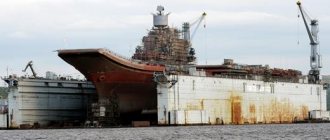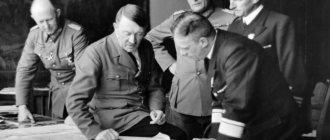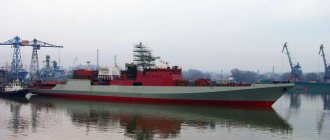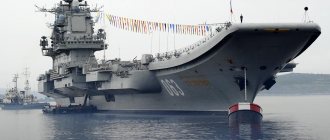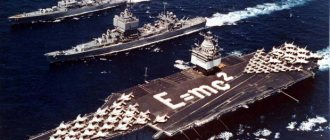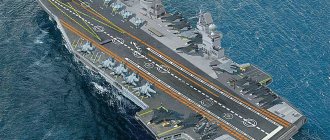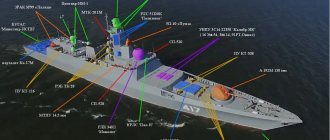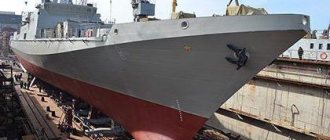Today, the Russian fleet has only one aircraft carrier, the Admiral Kuznetsov. It is unique in its class, but not alone in other characteristics. Assessments of the quality and usefulness of many Russian military equipment are most often ambiguous.
The aircraft carrier Admiral Kuznetsov could not avoid this either. Some say that he “laughs at NATO ships,” pointing to its powerful weapons, while others consider the ship “a disgrace to the Russian fleet,” supposedly it has been under repair for a long time.
But the aircraft carrier Admiral Kuznetsov had already fought and was awarded the Order of Ushakov, so they were too hasty in declaring its “shame.”
Admiral Kuznetsov - heavy aircraft-carrying cruiser (TAVKR) of project 1143.5
“Admiral of the Fleet of the Soviet Union Kuznetsov” (former names in order of assignment: “Soviet Union” (project), “Riga” (laying), “Leonid Brezhnev” (launching), “Tbilisi” (tests)) - heavy aircraft-carrying cruiser (TAVKR) project 1143.5, the only one in the Russian Navy in its class (as of 2016). Designed to engage large surface targets and protect naval formations from attacks by a potential enemy.
The birth of the Soviet aircraft fleet
The first signs in the Soviet navy were aircraft-carrying ships of Project 1123.1-3 class anti-ship missiles. These were helicopter-carrying cruisers, which received the code “Condor” according to NATO classification. The main means of combat of these ships was a dozen Ka-25 helicopters. The main function of ships of this class is to search for and destroy enemy submarines on ocean communications.
Further development of the aircraft-carrying component in the Soviet Navy was the Project 1143.1-4 aircraft-carrying cruiser of the “Kyiv” class. These were already ships that vaguely resembled aircraft carriers, both in terms of tactical and technical characteristics and functionality. The lead ship of this project, the heavy aircraft-carrying cruiser Kyiv, entered service in December 1975. On this ship, the main weapon was the air wing, consisting of 12 Yak-38 aircraft and 12 Ka-25 helicopters. In terms of displacement and size, these were large military vessels in the ocean zone, capable of operating as part of large formations of ships at a considerable distance from fleet bases. In total, 4 heavy aircraft-carrying cruisers of the Kyiv class were commissioned in the USSR. These warships for the first time demonstrated to the world the ability of Soviet shipyards to build aircraft-carrying ships.
It should be noted: In terms of the number of aircraft carriers launched and put into operation, the USSR was second only to the United States. Great Britain, which for a long time used aircraft carriers built during the Second World War, managed to build and commission only 4 ships of this class in the post-war period. In France, the construction of ships of the same type was limited to the construction of 3 units. Italy commissioned two aircraft carriers into its fleet, and Japan generally switched to building combined ships, aircraft-carrying destroyers and large landing ships.
In the USSR, after the commissioning of heavy aircraft-carrying cruisers of the Kyiv class, there was a tendency towards the transition to a full-fledged warship capable of providing a base for aircraft with horizontal take-off and landing. The aircraft carrier cruisers of Project 1143.1-4 served as a technological platform for the subsequent development of the Soviet aircraft carrier fleet. In this regard, the country's top military leadership had grandiose plans. It was planned to build larger and more powerful aircraft-carrying ships for the USSR Navy. An improved version of the project was the heavy aircraft-carrying cruisers of Project 1143.5-6, of which only the Admiral Kuznetsov TAVKR was launched and put into operation.
Aircraft carrier "Admiral Kuznetsov" - video
Named in honor of Nikolai Gerasimovich Kuznetsov, Admiral of the Fleet of the Soviet Union. Built in Nikolaev, at the Black Sea Shipyard. Part of the Northern Fleet. During cruises, the cruiser is used by MIG-29K, Su-25UTG and Su-33 aircraft of the 279th naval fighter aviation regiment (based at Severomorsk-3) and Ka-27 and Ka-29 helicopters of the 830th separate naval anti-submarine helicopter regiment (based airfield - Severomorsk-1), as well as the latest ship-based Ka-52K attack helicopters.
The aircraft carrier Admiral Kuznetsov has an extremely powerful and constantly modernized close-in missile defense system to repel missile and bomb attacks. The ship's anti-aircraft armament consists of 4 six-barrel launchers of the Kinzhal air defense system (192 missiles), 8 launchers of Kortik (256 missiles), 6 six-barrel 30-mm rapid-fire AK-630M launchers (48,000 shells). The aircraft carrier also has a very advanced layered defense against torpedoes from 2 RBU-12000 installations (60 missiles), including the setting of false acoustic targets, the rapid deployment of anti-torpedo minefields and the destruction of torpedoes with depth charges at the aircraft carrier itself. The aircraft carrier also has a survivability design with multiple bulkheads that can withstand up to 400 kg of TNT from ammunition below the waterline. Thus, an aircraft carrier can repel massive missile, bomb and torpedo attacks even without the help of the actual warrant, which can focus on destroying missile and torpedo carriers.
The aircraft carrier also carries 12 vertical launchers 4K-80 for heavy Granit missiles capable of hitting targets at a range of 700 km with a throw weight of 750 kg. The initial versions of the missile were created to destroy US aircraft carrier groups; recent upgrades to the complex allow it to hit coastal targets.
The aircraft carrier "Admiral Kuznetsov" is the only aircraft carrier in the world that can operate in the Black Sea, because... According to the Montreux Convention, the passage of clean aircraft carriers through the Bosporus and Dardanelles straits is prohibited.
The fifth heavy aircraft-carrying cruiser of the USSR Navy, “Riga,” was laid down on the slipway of the Black Sea Shipyard on September 1, 1982 (Nikolaev, Ukrainian SSR). It differed from its predecessors in that it was for the first time capable of taking off and landing conventional aircraft and modified versions of the land-based Su-27, MiG-29 and Su-25. To achieve this, it had a significantly enlarged flight deck and a springboard for aircraft take-off. Construction for the first time in the USSR was carried out using a progressive method of forming a hull from large blocks weighing up to 1400 tons.
Even before the completion of assembly, after the death of Leonid Brezhnev, on November 22, 1982, the cruiser was renamed in his honor to the Leonid Brezhnev TAVKR. It was launched on December 4, 1985, after which its completion continued afloat. Loading and installation of weapons on the aircraft carrier (except for the zonal block of launchers of the Granit anti-ship missile complex), electrical equipment, aviation equipment, ventilation and air conditioning systems, as well as equipment of the premises were carried out afloat, during the completion of the ship at the Northern embankment of the Big Bucket.
On August 11, 1987, it was renamed TAVKR "Tbilisi". On June 8, 1989, its mooring tests began, and on September 8, 1989, the crew began settling in. On October 21, 1989, the unfinished and understaffed ship was put out to sea, where it conducted a series of flight tests of aircraft intended to be based on board. As part of these tests, the first takeoffs and landings of aircraft were carried out on it. On November 1, 1989, the first landings of the MiG-29K, Su-27K and Su-25UTG were made. The first takeoff from it was made by the MiG-29K on the same day and the Su-25UTG and Su-27K the next day, November 2, 1989. After completing the test cycle, on November 23, 1989 he returned to the plant for completion. In 1990, she went to sea many times to conduct factory and state tests.
On October 4, 1990, it was renamed once again (4th) and became known as the TAVKR “Admiral of the Fleet of the Soviet Union Kuznetsov.”
Battle flagship
The flagship of the Russian Navy, the TAVKR Admiral Kuznetsov, is not only the largest ship, but also one of the few with solid combat experience, and if we talk about domestic aircraft-carrying ships, then the only one. In the fall of 2016, the cruiser headed the Northern Fleet ships to the Mediterranean Sea, from where its planes began to strike militants of terrorist groups in the provinces of Idlib and Homs. According to domestic and foreign military experts, the pilots of the 279th separate naval fighter aviation regiment based on the Admiral Kuznetsov, who took part in the hostilities, gained unique combat experience that few active military pilots in the world can boast of. How successfully the cruiser's pilots coped with their combat missions is evidenced by the following fact: in 2022, the cruiser was awarded the Order of Ushakov, one of the highest naval awards.
Service of TAKR "Admiral Kuznetsov"
On November 1, 1989, for the first time in the USSR, a Su-27K fighter (test pilot of the Sukhoi Design Bureau V. G. Pugachev) landed on the deck of the Tavkr Tbilisi aircraft. On the same day, the MiG-29K took off from the deck for the first time using a springboard (test pilot of the Mikoyan Design Bureau T. O. Aubakirov). Also on this day, the Su-25UTG training aircraft (test pilot of the Sukhoi Design Bureau Igor Votintsev and test pilot of the LII Alexander Krutov) made its first landing on the deck. On August 1, 1990, state tests began. During the tests, 16.2 thousand miles were covered, 454 aircraft flights were made. In May 1990, the ship was temporarily included in the 30th division of surface ships of the KChF.
In December 1991, the ship's commander received a telegram from the President of Ukraine Leonid Kravchuk, which explained that the cruiser is the property of Ukraine and until a government decision is made, it must remain in the Sevastopol roadstead. The command of the Russian Navy decided to transfer it to the Northern Fleet. At night, the ship left the Sevastopol roadstead and headed for the Bosphorus. On December 1-24, 1991, the cruiser made a transition around Europe to its permanent base in Vidyaevo, Murmansk region.
On December 25, 1990, 8 years, 3 months and 24 days after the laying, the acceptance certificate for the cruiser was signed. On January 20, 1991, it was officially transferred from Ukraine to Russia and enlisted in the Northern Fleet; on January 20, the naval flag was raised on it. In 1992-1994. Various tests of the ship, its weapons and air group continued, the cruiser spent three to four months a year at sea and participated in exercises. In 1993, the first production Su-33s began to arrive for his air group. In the winter of 1994-1995, the main boilers were repaired.
In the year of the 300th anniversary of the Russian Fleet, on December 23, 1995, as part of a naval multi-purpose group, it entered combat service in the Mediterranean Sea, having on board an air group consisting of 13 Su-33, 2 Su-25UTG and 11 helicopters. Gibraltar was passed after 10 days of the trek, on January 4, 1996. On January 7, 1996, she anchored off the coast of Tunisia until January 17. There was an exchange of visits with the US Navy, including the landing of Russian helicopters on an American aircraft carrier and vice versa, as well as the transportation of Russian pilots on US aircraft. From January 28 to February 2, he made a business call to Tartus. February 4, entry to the island of Crete. On February 17 - 18, he visited La Valletta. March 2 - air defense exercises with an aircraft carrier multi-purpose group with Su-33 practicing intercepting aircraft and cruise missiles. March 6 - passage of Gibraltar. At the final stage of the campaign, he took part in command post exercises of the Northern Fleet. As part of the exercise, a conditional repulse of an attack by 4 Tu-22M3s was carried out. They were intercepted at a distance of 450 km from the center of the warrant. On March 22, 1996, he moored at the base. In fact, 12 air targets were intercepted, two foreign submarines were discovered, and artillery and missile firing was carried out, including the Granit missile system. The entire voyage was accompanied by serious problems with the main power plant, as a result of which the ship repeatedly lost speed and could not reach full speed, as well as various problems with the ship's systems.
From 1996 to 1998 it was under renovation, which was greatly delayed as a result of underfunding. In 1998, he took part in major exercises of the Northern Fleet. In 1999, he went to sea twice for combat training. In 2000, he participated in major exercises, during which the nuclear-powered missile submarine K-141 Kursk was lost, and took part in a rescue operation. As a result of this tragedy, the cruiser's second trip to combat service in the Mediterranean Sea, which was supposed to take place at the end of 2000, was cancelled.
From 2001 to 2004 it was undergoing a scheduled mid-term renovation. In 2004, as part of a group of 9 ships of the Northern Fleet, including the heavy nuclear-powered missile cruiser "Peter the Great", the missile cruiser "Marshal Ustinov", the destroyer "Admiral Ushakov" and support vessels, took part in a month-long voyage to the North Atlantic, during which also flight development tests of the Su-27KUB. In 2005-2007 he carried out military service and went to sea two or three times a year. On December 5, 2007, as part of a naval strike group, he went on his second trip to combat service in the Mediterranean Sea, which lasted until February 3, 2008.
On December 5, 2007, “Admiral of the Fleet of the Soviet Union Kuznetsov” led a detachment of warships that set off on a voyage to the Atlantic Ocean and the Mediterranean Sea. Thus, the Russian Navy has resumed its presence in the world's oceans.
On December 8, 2008, repairs were completed, carried out for 7 months at the facilities. The main power plant on the ship was updated, work was carried out to repair boiler equipment, air conditioning systems, and mechanisms for lifting aircraft onto the flight deck. The cable routes were replaced, and individual units of the cruiser's weapons systems were restored.
On December 6, 2011, the TAVKR set off together with a detachment of ships of the Northern Fleet to the Mediterranean Sea - to the shores of Syria.
According to representatives of the Russian Ministry of Defense, the TAVKR requires a major overhaul and will probably undergo it from 2012 to 2022 at the Sevmash shipbuilding enterprise, however, due to lack of funding, repairs have been postponed indefinitely.
The ship's seventh long-distance voyage was completed in May 2014.
From May 14 to August 20, 2015, the TAVKR "Admiral of the Fleet of the Soviet Union Kuznetsov" was under repair at the dock of the 82nd ship repair plant in Roslyakovo.
From January to June 15, 2016, the TAVKR "Admiral of the Fleet of the Soviet Union Kuznetsov" was under repair at the 35th ship repair plant in Murmansk, where technical readiness was restored before a long sea voyage.
At the beginning of July 2016, it was reported that the ship would lead a permanent naval group in the Mediterranean Sea from October 2016 to January 2022, and would participate in Russia’s operation in Syria (previously the campaign was announced for the summer of 2016).
On August 8, 2016, a regular MiG-29KR fighter from the 100th separate naval fighter aviation regiment (OKIAP) of the Naval Aviation of the Northern Fleet made its first landing on the deck of the cruiser; It was also reported that from mid-August to October 1, the ship will be at the 35th shipyard to undergo the second stage of maintenance and restore technical readiness.
On October 15, 2016 at 15:30, a ship group led by the TAVKR "Admiral of the Fleet of the Soviet Union Kuznetsov" set off on its first military campaign to the shores of Syria. The group also included the TARKR "Peter the Great", large anti-submarine ships "Severomorsk" and "Vice Admiral Kulakov", as well as support vessels.
A brief history of the aircraft-carrying cruiser "Admiral Kuznetsov" and its features
In fact, the Admiral Kuznetsov is not an aircraft carrier in the usual sense, since in addition to the air wing, it also has heavy missile weapons on board, in particular Granit anti-ship missiles. That is why this ship is defined as a heavy aircraft-carrying cruiser, and the range of tasks it performs is somewhat different from the goals of conventional aircraft carriers.
The history of the Admiral Kuznetsov began back in 1981, when the ship’s design was approved and its construction began a year later. A difficult period in the life of the country influenced this process, so that the work lasted almost 10 years, and full commissioning was completed only by 1995.
The name of "Admiral Kuznetsov" changed very often - initially the aircraft carrier was called "Riga", then "Leonid Brezhnev", and after "Tbilisi" and only in 1990 the ship received its current name.
It was planned to release several ships of this type, united in the Kuznetsov class, while the Admiral Kuznetsov itself was to become the flagship. A sister ship, the Varyag, was even laid down at the Black Sea shipyard, but after the collapse of the Union, Ukraine sold its hull to the People's Republic of China, which completed construction on its territory.
Between 1991 and 2015, Admiral Kuznetsov made only a few combat missions, and major modernization on board was carried out only once.
In 2016, the aircraft carrier took part in the Syrian campaign, but after two incidents that led to the loss of aircraft, the air wing was decided to relocate to land. After this, Admiral Kuznetsov participated in exercises and then went to Murmansk for modernization, but the completion date of the work remains unknown. And later it will become clear why.
Assessment and prospects of the aircraft carrier "Admiral Kuznetsov"
Being the first full-fledged aircraft carrier in Soviet naval practice (that is, capable of receiving horizontal take-off and landing aircraft with high combat qualities), the Admiral of the Fleet of the Soviet Union Kuznetsov TAVKR, however, could not fully overcome the shortcomings of the first Soviet TAVKR type " Kyiv". The focus on replacing full-fledged steam catapults with springboards led to difficulties in takeoff and landing operations (due to the presence of only one direction for launch). On the other hand, the use of a springboard made it possible to significantly save on the mass, internal volume and energy required to accommodate, maintain and power the steam catapult system. Also, the abandonment of a complex system of steam catapults increased the combat stability of the air regiment in the event of failures due to malfunctions or combat damage to the entire system, and, as a result, the impossibility of using the TAVKR air regiment. The lack of specialized AWACS aircraft that could take off from a ski-jump resulted in a short radar detection range. As a result, the TAVKR's over-the-horizon detection capabilities were limited to AWACS helicopters that had a short range. BBC experts commenting on these shortcomings, because The very maintenance of an aircraft carrier and its order in a combat-ready state and their ability to travel long distances represents a serious projection of power.
The advantage of the unusual design of an aircraft carrier combining the weapons of a missile cruiser (aircraft-carrying cruiser) is that the Admiral Kuznetsov is in fact the only aircraft carrier in the world that can operate in the Black Sea. The fact is that the Montreux Convention of 1936 prohibits the passage of “clean” aircraft carriers through the Bosporus and Dardanelles straits, but does not prohibit the passage of missile cruisers, which are additionally aircraft carriers, for the USSR and Russia.
The presence of the Granit anti-ship missile system, perfect for its time, with missile defense/air defense breakthrough technologies was intended to create an advantage for the ship in a duel with other aircraft carriers and their orders, since the Granit anti-ship missile system was designed to ensure that, without raising its air wing, the Admiral Kuznetsov "could attack an enemy carrier group with a missile salvo. For a long-range strike, the complex requires precise target designation, carried out by the “Success” aviation complex from Tu-95RTs aircraft, Ka-25Ts helicopters or other systems for obtaining approximate target coordinates. There is a fairly popular urban legend that the Granit SCRC cannot function without target designation from the Legend MCRC, which has been decommissioned. However, even the initial versions of the Granit anti-ship missile system do not require control in flight and when attacking a target, since they simply require entering the target coordinates obtained in some way during launch, then the missile followed the inertial navigation system and at the finishing stage independently found targets using its radar . In 2001, NPO Mashinostroeniya, in accordance with the Resolution of the Council of Ministers of Russia, began work on modernizing the on-board equipment of the Granit complex missiles to transfer navigation and computing electronics to the same element base with the export version of the Yakhont anti-ship missile system with its navigation systems and radio-electronic equipment. At the same time, it is planned to extend the service life of the missiles to 30 years, and the service life of the ship elements of the complex - for life for the carrier. On October 16, 2016, a previously unannounced version of the Granit modernization was tested to attack coastal targets; many experts like Konstantin Sivkov believe that this is the most likely use of the Granit, which is ending its service life. Granites can be very effective for hitting area targets, provided that the enemy has suppressed or does not have a local missile defense system, because have a record weight and range for missile-thrown ammunition - 750 kg at 700 km.
Due to the deployment of Granit missiles, the aircraft carrier has a relatively small hangar.
In April 2016, National Interest and other sources reported on the Russian Navy's plans to replace the Granit with universal launchers based on the ZS-14 for more compact cruise missiles of the Kalibr and Oniks families, as well as the new Zircon missile, which has hypersonic speed to break through modern missile defense systems. Judging by the satellite images of the Admiral Nakhimov undergoing repairs, the Granit launchers are already being dismantled there and the ZS-14 is being installed. The Admiral Kuznetsov, in turn, should undergo comprehensive repairs and modernization from 2022, during which the Granit is expected to be replaced by modern missile weapons.
BBC experts, assessing the aircraft carrier project, note that its most important significance for the Russian Navy is maintaining experience in using aircraft carriers and the presence of both specialists and pilots who know how to handle equipment on aircraft carriers. This allows both the efficient modernization of the aircraft carrier and the use of experienced personnel to create new Russian aircraft carriers. In this regard, BBC experts note that if the aircraft carrier is used in a real strike operation in Syria, the Russian Armed Forces will gain experience that few countries in the world have.
The place of the aircraft carrier in naval strategy
The end of the Second World War clearly showed with what weapons it is possible to achieve supremacy at sea. The geopolitical picture in the world has also changed. Britain, due to large military losses at sea and the difficult post-war economic situation, lost its status as the Mistress of the seas and oceans. The Royal Navy, the navies of France, Italy and Japan ceased to be a serious naval force in the post-war period. The leading naval power, which managed not only to preserve, but also to increase its naval forces during hostilities, became the United States of America. By the end of the war, the US Navy consisted of 1,500 ships of all classes, of which there were 99 aircraft carriers alone.
It should be noted that the US military was the first to come to the conclusion that the future of the navy belonged to aircraft carriers. It is much more convenient to carry out your own policy in the world not with battleships and cruisers, but with the help of aircraft carriers. The gunboat policy was replaced by an aircraft carrier strategy. Naval forces possessing ships of this class become a convenient and flexible military instrument, capable of solving tactical and strategic problems in the zone of free access to the coast.
For reference: TAVKR "Admiral Kuznetsov" is the only aircraft-carrying ship in the world that can freely operate in the Black Sea, enter and exit through the Black Sea straits of the Bosporus and Dardanelles. The Montreux Convention prohibits the passage of aircraft carriers into the Black Sea. Soviet aircraft-carrying cruisers became a successful military-technical solution that allowed the Soviet Union to have ships of this class in this area.
Subsequent military conflicts, the Korean War, and military operations in Indochina demonstrated the leading role and place of aircraft carriers in naval strategy. This was well known not only in Washington and London, where the construction of aircraft carriers did not stop. The need to have aircraft carriers in their fleet was quickly realized by the governments of France and Italy, where after the war they began building their own ships of this class. Following the leading world powers, third world countries joined this process. Aircraft carriers, although of old construction, appear in the fleets of Brazil, Argentina and India.
The Soviet Union also considered the idea of building aircraft-carrying ships with particular interest. The naval confrontation between the USA and the USSR that emerged in the post-war years only accelerated the work of domestic design bureaus in this direction. However, the first Soviet full-fledged aircraft carrier, the aircraft-carrying cruiser Admiral Kuznetsov or TAKR, entered service only in the winter of 1991, when the USSR had already disappeared from the political map of the world. The main reasons for such a protracted start were the policies of the Soviet leadership, which initially relied on the creation of a nuclear missile submarine fleet, and the lack of experience in building ships of this class in the Soviet Union.
Commanders of the aircraft carrier "Admiral Kuznetsov"
During its service the ship was commanded by:
- Captain 1st Rank V. S. Yarygin (1987-1992); - Rear Admiral (assigned while commanding the ship) I. F. Sanko (1992-1995); - Rear Admiral (assigned while commanding the ship) A. V. Chelpanov (1995-2000); - Captain 1st Rank A. V. Turilin (2000-2003); - Captain 1st rank A.P. Shevchenko (2003-2008); - Captain 1st Rank V. N. Rodionov (2008-2011); - Captain 1st Rank S. G. Artamonov (since 2011).
Incidents on the TAVKR "Admiral Kuznetsov"
— On October 19, 1995, a Mi-8 helicopter crashed. While taxiing on the flight deck, the helicopter was overturned by a strong crosswind. The ship did not receive any damage. The aircraft's main rotor was completely destroyed. A fragment of the blade hit the officer's hand and tore out the bone.
— On October 18, 2004, a Su-25UTG accident occurred. The plane made a hard landing, as a result of which its right landing gear broke. Major damage to the cruiser was avoided due to the fact that the Su-25UTG caught the landing hook on the arresting arrester cable. The suspected causes of the accident include crew error and metal fatigue. The aircraft was delivered to the 121st ARZ (Kubinka), but was declared beyond repair, after which it was written off.
— On September 5, 2005, two emergency landings of Su-33 fighters occurred at the TAVKR in the North Atlantic. One of the fighters fell into the ocean and sank at a depth of 1,100 meters (Lieutenant Colonel Yuri Korneev, who was flying the plane, ejected), the second stayed on the deck. The cause of both accidents was a broken arrestor cable. It was planned to destroy the sunken plane with depth charges due to the presence of secret equipment (for example, a “friend or foe” identification system), but it turned out that this was impossible to do. The Navy command expressed hope that the plane would collapse on its own.
— On January 6, 2009, while stationed at the roadstead as part of military exercises at the Turkish naval base Akzas, a fire occurred on board the aircraft carrier in one of the bow rooms. The fire was extinguished by the ship's crew. As a result of carbon monoxide poisoning, conscript sailor Dmitry Sychev died. According to experts, the TAVKR did not receive serious damage and on January 11 took part in joint exercises with Greece.
“The company is no stranger”
It is always difficult to finish work planned and started by someone and meet deadlines in any field of human activity, but here is a unique hydraulic structure in difficult climatic conditions with difficult soils. It is obvious how much more difficult it is to implement a project with a ready-made full storyboard.
“At the initial stage of work, it was very important to join this project and minimize downtime on the site that arose after the departure of the previous contractor,” explains the executive director of Orgenergostroy. “Therefore, immediately after the announcement of our victory in the competition, we began mobilization, without waiting for the final signing of the agreement.” This allowed the company to bring more than 30 pieces of heavy equipment to the site within a few days after signing the contract and immediately begin work. In order not to slow down the pace of work, Orgenergostroy, without waiting for an advance, invested its own money (working and borrowed) into the project - about one and a half billion rubles.
“Mobilization to the site was extremely difficult under the conditions of Covid restrictions,” said Deputy Head of Dock Construction Alexander Chuchkevich, “but our company is no stranger to this. We work in different parts of the world and often face difficulties: how to bring it, how to get there, how to get permission to enter.” According to him, this experience allowed, despite Covid restrictions, not to slow down the pace of construction, but to mobilize.
As part of the first stage of work at the site, Orgenergostroy radically changed the construction technology and adjusted many design solutions. No less amount of work was done at the second stage.
“We started with a revision and assessment of design solutions,” explained German Kokosadze. “As a result of this work, certain inconsistencies were identified in the geological and hydrogeological conditions of the site and certain design solutions, but after additional research, our company’s specialists updated some of the design solutions and completely changed the technology for performing the work.”
German Kokosadze told Lenta.ru that for the most difficult sections of the pipe and pile wall, the technology was tested five to six times to achieve the optimal result. This is a normal process in hydraulic engineering; it takes time. To implement the technologies, unique foreign pneumatic impact equipment was purchased for working in rocky foundations; the company mobilized some of the heaviest drilling rigs that we have in the country, and applied the most modern technologies for dismantling concrete structures.
With the help of seismologists from Orgenergostroy, it was possible to reduce the seismic level of the site from eight to six, which made it possible to reduce the volume of concrete from 220 thousand cubic meters to 180 thousand. In addition, the basic design solutions were changed, more modern hydraulic concrete was used, which increased the durability of the dock under construction. According to German Kokosadze, this made it possible to achieve savings in terms of cost and timing of the project compared to the previous design solution.
In addition, Orgenergostroy, focused on the needs of the customer, in addition to one option for docking the Admiral Kuznetsov proposed by the previous designer, developed two additional ones so that USC, together with the Ministry of Defense, could choose the most optimal one for repair work on the Admiral Kuznetsov.
And to minimize collisions on the site and reduce the implementation time of the second stage of the project, all design is carried out using BIM technologies in a three-dimensional environment.
Armament of the aircraft carrier Admiral Kuznetsov
— Navigation weapons: Beysur complex
— Radar weapons: 1 × radar with phased array “Mars-Passat”; 1 × MR-750 Fregat-MA radar; 2 × MR-360 “Podkat” radar; 3 × Vaygach radar - aviation control system: 1 × Resistor-K42; 1 × "Lawn"
— Electronic weapons: CIUS “Lumberjack”; Communication complex "Buran-2"; SJSC "Polynom-T"; GAS "Zvezda-M1"; Electronic warfare complex "Sozvezdie-BR"
– Anti-aircraft artillery: 6 × 6 AK-630 (48,000 rounds)
— Missile weapons: 12 × Granit launchers; 4 × 2 ZRAK "Kortik" (256 missiles, 48,000 shells); 4 × 6 launchers of the Kinzhal air defense system (192 missiles)
— Anti-submarine weapons: 2 × 10 RBU-12000 (60 bombs)
Aircraft of the aircraft carrier Admiral Kuznetsov
— Aviation group: 50 airplanes and helicopters — According to the project: 26 × MiG-29K or Su-27K; 4 × Ka-27RLD; 18 × Ka-27 or Ka-29; 2 × Ka-27PS - Actually: 14 × Su-33; 2 × Su-25UTG; 10 × MiG-29K; 4 × MiG-29KUB
Tactical and technical characteristics of the aircraft carrier Admiral Kuznetsov
Home port: Murmansk-35 Commissioned: January 20, 1991
Displacement of the aircraft carrier Admiral Kuznetsov
— 61,390 tons maximum; 59 100 t full; 53,050 t normal; 46,540 t standard
Dimensions of the aircraft carrier Admiral Kuznetsov
— Length: 270 m at the waterline; 306.45 m greatest - Beam: 33.41 m at waterline; 71.96 m greatest - Height: 64.49 m overall - Side height (from the vertical line): 31.42 m at the bow; 25.7 m amidships; 25.7 m at the stern - Medium draft (from OP): with a standard displacement of 8.05 m; with a normal displacement of 8.97 m; with a full displacement of 9.76 m - Maximum: 10.4 m - Reservation: Rolled steel, duplicating the hull with “dry compartments”. Anti-torpedo three-layer protection 4.5 m wide, withstands hits of 400 kg of TNT charge.
Engines of the aircraft carrier Admiral Kuznetsov
— Boiler-turbine, four-shaft — Steam turbines: 4 GTZA TV-12-4 — Number of boilers: 8 KVG-4 boilers
Power - Steam turbines: 4 × 50,000 hp — Turbogenerators: 9 × 1500 kW — Diesel generators: 6 × 1500 kW — Propulsion: 4 five-blade propellers — Speed: 29 knots (54 km/h) maximum; 18 knots (33 km/h) combat economic speed; 14 knots (26 km/h) economic speed
Cruising range
— At speed: 29 knots — 3850 miles; 18 knots - 7680 miles; 14 knots - 8417 miles - Navigation autonomy: 45 days
The crew of the aircraft carrier Admiral Kuznetsov
— 1980 people, including: 520 officers; 322 midshipmen; 1138 sailors.
“We’ll hand over the finished dock”
The first deputy of the separate division of Orgenergostroy in Murmansk, Pavel Nekrich, is sure that any hydraulic structure is a unique object: “Probably, any object that is especially dangerous is unique. But this is a challenge for every participant in large-scale construction working here. We understand what vessel the work is being done for.”
Photo: Vasily Maksimov / Kommersant
USC understands the difficult conditions in which the Orgenergostroy Institute has to work, and this is not only about the climate of Murmansk. A source at USC told Lenta.ru that “the new general contractor received, figuratively speaking, not a blank white sheet of paper, but a grey, fairly wrinkled and faded one”: “On the one hand, we demand deadlines from them, on the other hand, we try to meet halfway and find a middle ground, realizing that their difficulties are objective. But we understand that the work must be done efficiently.” Therefore, according to an USC employee, they are in close contact with Orgenergostroy employees in order to avoid mistakes of the past: “Admiral Kuznetsov is the only one we have, and there can be no mistakes under any circumstances.”
Currently, builders are close to completing the first stage of work, which they plan to complete by the end of April - beginning of May, and have already built a two-row cofferdam, the main component for creating a pit, separating it from the Kola Bay. Pavel Nekrich said that “pumping groups will be installed on it for pumping out and reinjecting water into construction pits.”
The second stage of work at the site will last a little more than a year and a half; it includes the docking of the Admiral Kuznetsov, for which builders will prepare for four to five months. “At the end of the work, after all the docking, we will hand over the finished dock, a turnkey structure with a landscaped area, with all the necessary stations,” explains Pavel Nekrich. “We will switch wastewater from the plant to treatment facilities, that is, we will replace all the old equipment.”
